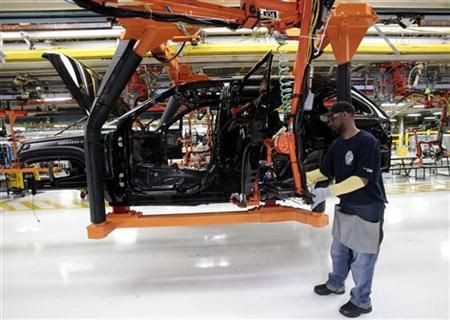Chrysler Goes Manual In Engine Production To Speed Output Of Tigershark Engines For 2013 Dodge Dart, 2014 Jeep Grand Cherokee

Like other car companies, Chrysler Group LLP is riding a crest of robust U.S. demand that’s pushing the leaner Detroit 3 automaker to the limits of its capacity. Now the No. 3 U.S. carmaker is responding by utilizing a very familiar resource.
Earlier this year, the maker of the Ram, Dodge and Jeep brands realized it would need to scale up capacity to meet this demand but didn’t have time (or cash, really) to set up more robotic production capacity at the company’s factories. And considering that the U.S. government’s increasingly strict fuel efficiency and emissions standards will probably require future reconfigurations of powertrain lines, Chrysler is erring on the side of caution and utilizing more people power to make its new, more-efficient four-cylinder Tigershark engines. In other words, it’s more cost-effective to use human beings because they adapt better and are less expensive than reconfiguring robotic assembly lines.
This was the takeaway from an interview with Brian Harlow, Chrysler’s head of North American powertrain manufacturing, who spoke to the Detroit News in a report published Friday.
“We’re running our [powertrain] plants, literally all the time, at capacity-plus,” said Harlow. “We needed to build a new line for assembly. We needed that in three to four months, which in our business is unheard-of.”
The Tigershark engines have advanced technologies, such as dual variable-valve timing and a flow-control valve intake manifold, which means less horsepower but greater fuel efficiency.
The development of the Tigershark engine is part of Chrylser's response to a 2012 government standard requiring cars and light trucks to get at least 54.5 miles per gallon (or the equivalent, in the case of hybrids) by 2025, an effort that tasks all automakers with innovating more-efficient drivetrains. Chrysler, a majority-owned subsidiary of Italy’s Fiat SpA (BIT:F), is utilizing Fiat’s “World-Class Manufacturing” system adapted through the help of Japanese expertise.
The 2013 Dodge Dart, which represents 14 percent of all Dodge sales this year, saw U.S. deliveries more than double in August compared to the same month last year, to 6,901 units. The new Dart went into production in May 2012 and has sold nearly 62,000 units in the U.S. since. It uses either the 2.0-liter or 2.4-liter Tigershark I4. The 2014 Jeep Grand Cherokee, due out later this year, will have a Tigershark engine.
Though Harlow didn’t mention how many more engine assembly workers have been added to meet this demand, he pointed out that the company has added an extra line of employees to its Trenton North Engine plant in Michigan after realizing its highly automated Dundee Engine Plant, also in Michigan, could not produce engines fast enough. Chrysler plants in Mexico, Brazil and China will get similar treatment, added Harlow.
© Copyright IBTimes 2024. All rights reserved.






















